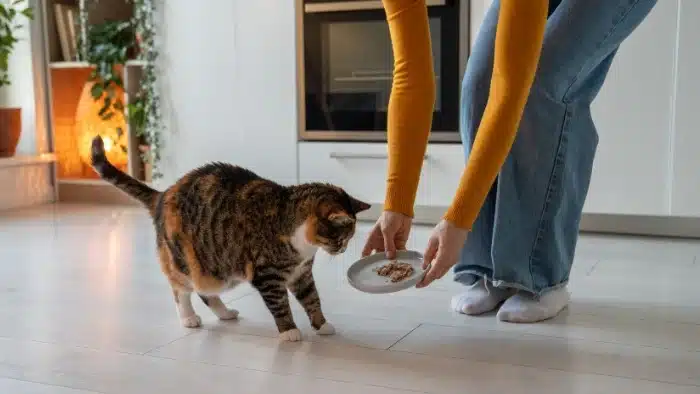How to feed a cat before giving birth?

1. Late Pregnancy Nutrition: Targeted Supplements, Not Overfeeding
In the final 2–3 weeks (weeks 6–9), kittens grow quickly and need more nutrients. However, the mother’s digestive system is under pressure from the uterus, so she can’t eat large meals. That’s why quality is more important than quantity.
- Protein is the most important. At least 80% of her daily protein should come from animal sources (like chicken breast, beef, or salmon). This supports kitten growth and keeps the mother strong. Increase protein to 40%–50% of her diet (regular adult cats need 25%–30%), but don’t overfeed.
- Fat should be added in moderation. Too much causes weight gain and a harder delivery. Keep fat at 20%–25%, and choose good sources like fish oil or egg yolk. Omega-3 helps kitten brain development and reduces inflammation.
- Calcium and phosphorus need to stay in balance. Too little calcium can cause seizures after birth; too much can make the kittens’ bones too hard and complicate labor. Use pet pregnancy calcium tablets (dosage based on weight) and feed phosphorus-rich foods (like dried small fish). Aim for a calcium: phosphorus ratio of 1.2:1.
- Add vitamin B (boosts appetite and metabolism) and folic acid (prevents birth defects). These small additions are the building blocks for a healthy delivery.
2. Diet Structure: High-Quality Pregnancy Food + Natural Add-ons
Your cat’s main food should be complete pregnancy cat food, specially designed for pregnant cats to ensure balanced nutrition. Check the ingredients: real meat should be the first item (not meat meal), and it should include folic acid, DHA, and a calcium-phosphorus balance. Avoid foods high in grains (corn/wheat over 20%) or with artificial flavor enhancers.
Start switching to this food around week 6 of pregnancy, using a 7-day transition plan (Day 1: 10% new food, Day 2: 20%, etc.) to avoid stomach issues.
You can also add small amounts of natural side foods, but limit them to 20% or less of the daily total:
- Boiled chicken breast: 50–80g per meal, 3–4 times a week. Tear into small pieces and mix with food.
- Steamed boneless salmon: 30–50g, 1–2 times a week. Rich in DHA and Omega-3.
- Egg yolk: 1/4 yolk, 2–3 times a week. Supports milk production.
Avoid:
- Raw meat (risk of parasites),
- Liver (too much can cause vitamin A toxicity),
- High-sugar foods (like rice or bread)—they take up space but offer little value.
3. Feeding Method: Small Meals, More Often
In late pregnancy, the uterus presses on the stomach, so your cat can’t eat much at once. Feed small amounts, more frequently—4 to 5 times per day is ideal (e.g., 7:00, 10:00, 14:00, 18:00, 22:00). A single meal should last 5–10 minutes to prevent spoilage and overeating.
Example: a 3kg cat should eat 120–150g total per day (100–120g pregnancy food + 20–30g side food), split into five meals of 24–30g each. This helps maintain a light hunger without overwhelming her stomach.
Soften dry food with warm water or goat milk powder to create a mushy texture—it’s easier to eat and boosts water intake (which should increase by 50% at this stage). Use shallow, wide bowls (ceramic or stainless steel), placed in a quiet, warm spot away from litter boxes or drafts. A relaxed setting improves digestion.
After each meal, gently stroke her belly (from chest to abdomen) for 30 seconds to help digestion and reduce gas.
4. 1–3 Days Before Birth: Reduce Food to Clear the Gut
In the final 1–3 days, reduce food to help empty the digestive system before labor. Too much food in the stomach during birth can cause discomfort or vomiting.
- 3 days before: cut daily food by 10%–15%, especially side foods. Stick to 80% of the normal amount of pregnancy food. By now, the kittens are developed, and extra nutrition isn’t needed.
- 1–2 days before: reduce again by 10%. Switch to easily digested soft foods, like food mush made with goat milk powder or plain chicken puree. Feed small meals (50% of the usual amount), 6 times a day. This keeps her stomach half-empty and comfortable.
Make sure she drinks plenty of water. Labor causes fluid loss, and dehydration may lead to low amniotic fluid or difficult labor. Offer warm, fresh water at all times. You can also add a small amount of pet electrolyte powder to help.
Avoid gas-producing foods (beans, onions, cabbage), which may cause bloating and affect contractions. If she eats less than half her usual amount, that’s normal—don’t force-feed her. Her body is adjusting naturally for labor.
In summary:
Feeding a cat before delivery means combining targeted nutrition, controlled portions, and flexible responses. Avoid both overfeeding and underfeeding. The final weeks are critical for the mother’s health and the kittens’ future.
- 2–3 weeks before birth: Boost protein, keep calcium-phosphorus in balance.
- 1–3 days before birth: Reduce food, focus on digestion.
- Adjust based on your cat’s behavior and condition.
Smart feeding builds a strong foundation for a safe delivery and healthy kittens.
